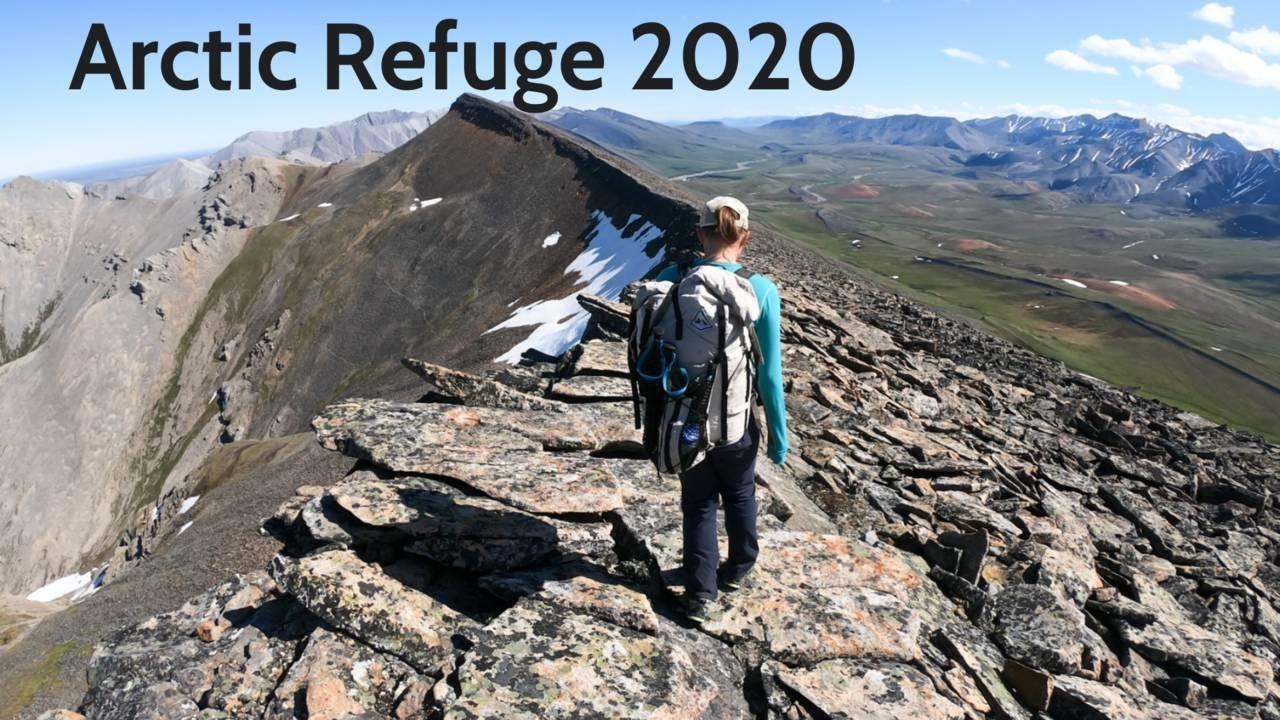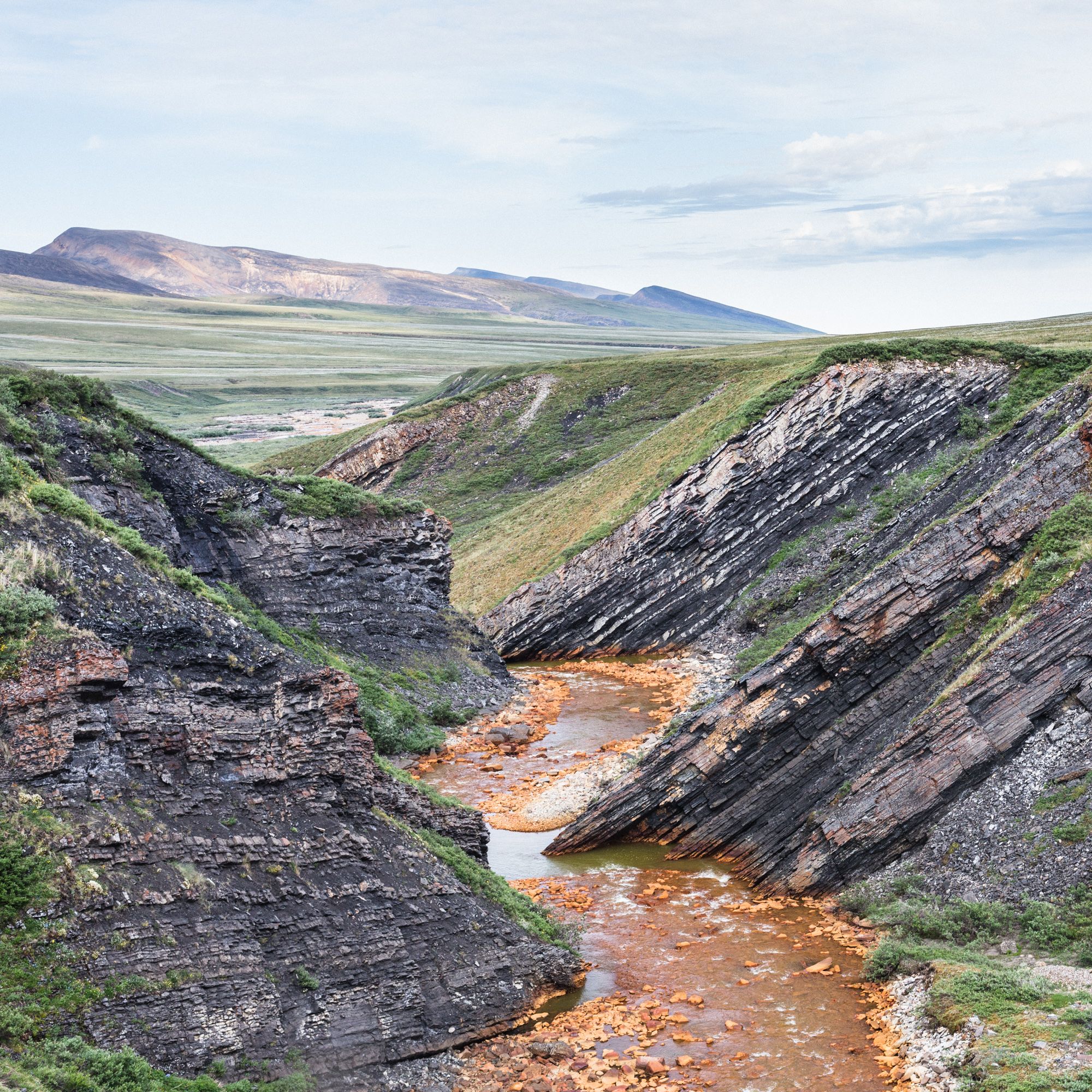Arctic Refuge 2020

Luc and I had lots of ideas about potential summer trips for 2020, but when COVID hit and rural villages across Alaska shut down-- with rightful concerns about limited medical infrastructure and intergenerational trauma from the Spanish Flu-- we knew we needed to adapt our recreation plans to keep us self-supported, out of villages & on the road system.
Luc put his trip-planning skills to work and came up with a ~350 mile loop that started & ended on the Haul Road, got us out to the Sadlerochit Mountains (which we'd wanted to explore since we floated past them in our 2017 Arctic Refuge Traverse) and incorporated a food drop that some friends of ours already had planned. We pulled in Will Koeppen (the pics in this post are Will's, & I'd encourage reading the daily journal entries he posted on his Instagram, starting here) and hit the road.
My biggest take-away from this trip was how well the nervous system and mind/body training I've been practicing for the last few years has been working. The trip wasn't all easy, but for the first time I was consistently able to use my tools to meet the challenges without getting stuck in my survival/stress responses of shutdown/overwhelm/freeze or fear/blame. AND I noticed that some challenges that previously would have kicked off a stress response just didn't -- instead I felt calm, capable, and aware of my resources. It was a huge win for nervous system and mindset work, and so fun to see super concrete results after YEARS of doing this work!
The trip broke down into three ~1-week sections:
- Hike & packraft into the Arctic Refuge
- Hiker's loop in the Sadlerochits and Shubliks
- Exit via packraft & hiking to the Arctic Coast and Prudhoe Bay
Leg One: Into the Arctic Refuge
We'd attempted to time this trip with early spring in the Brooks Range, hoping to beat the bugs and follow the arc of melting snow, baby birds, and spring wildflowers. But even in Anchorage, it felt like spring was a couple of weeks early this year... and the Brooks Range was no different.


Our first couple of days were buggy and hot, and we braced ourselves for what that could mean. Thankfully, the further into the mountains we got the better the mosquitos got, and that initial dose of bug attacks helped us stay appreciative of the bug-free moments throughout the trip.
This leg took us through a favorite area of mine from our 2017 traverse, a gorgeous 'hidden valley' and sweet 2.5-mile sheep trail with a view. So much of our backcountry trips involve exploration of new places, and I found I really enjoyed the opportunity to revisit an old favorite. It brought back a bunch of good memories from that trip, and I enjoyed the comfort of having an idea of what to expect and the ability to notice what had changed in three years.


At the end of this leg (the day after Summer Solstice) we woke up to a couple of inches of snow. Such a contrast from the heat from just a few days before!
This day was one of the times I concretely felt the impact of my nervous system work. We spent the day packrafting in snow/sleet/hail, wind, and splashy water, wearing all of my layers to stay warm enough. Being in challenging temperatures, with the possibility of a capsize and no extra dry layers to put on if that were to happen often creates a feeling of vulnerability for me, which can turn into gripped white-knuckling through fear & a state of full-focus hypervigilance that makes the day super stressful and me exhausted.




This time, though, I was aware of the vulnerability AND able to recognize my capacity-- I'm absolutely able to boat safely on the kind of water we were on, and my resources-- if something did go wrong, my partners and I could handle it. It felt like an incredible relief to be able to get through (and laugh at!) the crappiness of the conditions without feeling so threatened by them. And so proud that my work in this area is paying off!
Leg Two: Hiker's Loop in the Sadlerochits & Shubliks
After gathering qiviut and camping on a gravel bar covered in musk-ox tracks, we floated past a group of ~18 (with babies!) in the morning, en route to the start of Leg 2, our Hiker's Loop.
We cashed our boats and a week's worth of food, and started up into the Sadlerochit Mountains with light packs and tons of options. One of our main goals was to hike a 10 mile ridge that Luc had scouted from Google Earth, but when we climbed up to the ridge (passing a ton of coral fossils on the way) we found a loose talus pile instead of the easy-breezy walking that we'd anticipated.


None of us had ever been on a ridge made of talus, so at least it was novel if not exactly pleasant. I thought a lot about the "balance challenges" I incorporate in my workouts, and how relevant they are to walking on tippy rocks that could move under you at any time. And tried to stop and look around frequently, because the views were gorgeous but you couldn't really appreciate them and walk on those rocks at the same time!

Once we completed the ridge, we had to make a decision about what to do with the rest of our Hiker's Loop time. The options we'd scouted from Google Earth looked less appealing, now that we knew that the Sadlerochit ridges weren't as welcoming as we'd hoped. One option was to basecamp and explore from there, and another more ambitious option set us up for ~14 mile days and over what looked like a tricky pass. I spotted another, even more ambitious option (~16 mile days) with an easy-looking pass, but coming off the slow & unstable walking on the ridge it felt silly to sign ourselves up for the kind of big mileage days that only work when the walking is good. We slept on it.
In the morning, I woke up with energy and curiosity about the big loop. Luc & Will were game, so we took off in that direction thinking we could always adapt the plan if we needed to. We saw a bear sleeping belly-up in the sun; when it first heard us half-woke up, looked over, then looked just like it had hit snooze and laid its head right back down. Lazing around like that bear sounded pretty good too, and when we hit some slow hours of cotton grass tussocks my overwhelm about what we'd chosen crept in. I was able to use some inner child soothing techniques to calm my reactive parts, and return to moving from a more centered place.
And then, midway through the first day we hit caribou trails and everything improved. With their help ended up covering 19 miles, up and over the easy pass.




The next day we crossed through a couple of miles of cotton grass tussocks into the Shubliks, and once we hit the Shubliks we were set. The ground was hard and flat, perfect for pleasant, fast travel with caribou trails to follow and super cool river canyons that kept surprising us with their beauty.




I really love it when we hit the "good walking" parts of trips, and the Shubliks ended up being my favorite part of this trip. The ground stayed solid, the canyons kept coming, we covered our daily mileage without too much struggle, and our packs kept getting lighter. When we got back to our cache (undisturbed!) after completing the extra-ambitious loop with half a day to spare, we were feeling proud, tired, and lucky. It's rare to find hiking conditions that allow for pleasant, big days like that in Alaska!
Leg Three: Exit to the Arctic Ocean & Prudhoe Bay
Our exit started with a 10-mile portage to the Kavik River, which we hoped had enough water to float us out to the Arctic Ocean. We'd been bracing ourselves for the portage, anticipating cotton-grass tussocks and tough travel. Our loaded packs felt especially heavy after a week of walking without our boats, and the tussocks were a grind after the pleasant Shublik walking, but we covered the 10 miles in 7 hours and were pleased to make it to the Kavik with enough energy to float a bit.


Once in our packrafts, we realized that the Arctic headwind had died down around 10pm and that evening/night was likely the best time to make miles on the Kavik, which ended up being a super low flow river without much current. We floated until 2am that night, and then fully swapped our days and nights for the rest of the 60-mile float.
The overnight paddles lent themselves to big skies, cold temps, and animals. A huge highlight was floating past a heard of ~2,000 caribou, with more coming that we weren't warm enough to stick around for.


I also really enjoyed watching the midsummer sun dip toward the horizon (we were floating straight north, right into the sun); it got down to a couple of inches above the horizon at 2am and then headed back up. And by 3am I could feel the temperature increase too.


When we got to the coast, we started walking west toward Prudhoe Bay. The beach-walking was fairly pleasant, we saw lots of caribou and waterfowl, and enjoyed the novelty of the sea-ice floes. We used our packrafts to access the Barrier Islands, with even more waterfowl & nests on them, and kept ourselves moving to stay warm in the ~35 degree temps and damp sea-fog.




Our finish brought us up the Sag River and into Deadhorse. We'd been crossing more and more oil industry impacts since starting on this leg, and the climax was walking under a feeder pipeline and into the big-industry gravel zone that is Deadhorse. The cold, grey sea-fog that was rolling around didn't help with the feeling of doom and gloom there; such a contrast from our weeks of wild travel & no human contact.




We celebrated our finish with some quick hugs & cheers for our accomplishment, changing into warm dry extra layers from the car, and a quick drive south looking for the edge of the sea fog so we could have a more pleasant campsite.
Read Luc's full write-up with pics & notes
